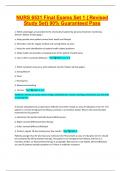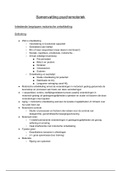NURS 6531 Final Exams Set 1 { Revised
Study Set} 90% Guaranteed Pass
1. Which advantages are provided to the chronically ill patient by personal electronic monitoring
devices? (Select all that apply.)
a. Helps provide more patient control their health and lifestyle
b. Eliminates need for regular medical and nursing follow-up visits
c. Helps the early identification of patient health-related problems
d. Helps health care providers in keeping track of the patient's health status
e. Cost is often covered by Medicare *Ans* ANS: A, C, D, E
1. Which symptoms may occur with vestibular neuritis? (Select all that apply.)
a. Disequilibrium
b. Fever
c. Hearing loss
d. Nausea and vomiting
e. Tinnitus *Ans* ANS: A, D, E
Vestibular neuritis can cause severe vertigo, disequilibrium, nausea, vomiting, and tinnitus, but not fever
or hearing loss.
A 25-year-old patient has a tuberculosis (TB) skin test which reveals an area of induration of 12 mm. The
patient is a recent immigrant from Mexico and lives in a homeless shelter. What is the recommended
treatment for this patient?
a. Administer the bacillus Calmette-Guérin (BCG) vaccine
b. Begin isoniazid (INH) preventive therapy
c. Order isoniazid (INH) and Rifampin
d. Perform regular TB skin testing every few months *Ans* ANS: B
Patients younger than 35 who have any risk factors for TB and with an area of induration 10 mm should
be considered for INH preventive therapy. This patient is an immigrant from Mexico and lives in a
homeless shelter, so TB preventive therapy is acceptable. BCG vaccine is not helpful. INH and Rifampin
are used if patients develop symptoms or if there is antibiotic resistance.
,A 35-year old patient develops acute viral bronchitis. Which is the focus for the management of
symptoms in this patient?
a. Trimethoprim-sulfamethoxazole therapy
b. Antibiotic therapy
c. Supportive care
d. Antitussive therapy *Ans* ANS: C
The mainstay of treatment in acute bronchitis is directed toward symptom reduction and supportive
care. Data suggest that 85% of patients diagnosed with acute bronchitis will improve without specific
treatment. Trimethoprim-sulfamethoxazole is prescribed for pertussis when macrolides are not an
option. Antibiotic therapy is not effective in treating
viral acute bronchitis.
A 50-year-old, previously healthy patient has developed gastritis. What is the most likely cause of this
condition?
a. H. pylori infection
b. NSAID use
c. Parasite infestation
d. Viral gastroenteritis *Ans* ANS: A
H. pylori accounts for most cases such as gastritis, duodenal ulcers, and gastric ulcers. NSAID use is an
important cause, but not likely in a previously healthy individual. Parasites are the leading cause
worldwide, but not in the United States. Viral gastroenteritis usually does not cause chronic gastritis and
usually has lower GI symptoms.
A 55-year-old patient has a blood pressure of 138/85 on three occasions. The patient denies headaches,
palpitations, snoring, muscle weakness, and nocturia and does not take any medications. What will the
provider do next to evaluate this patient?
a. Assess serum cortisol levels
b. Continue to monitor blood pressure at each health maintenance visit
c. Order urinalysis, CBC, BUN, and creatinine
d. Refer to a specialist for a sleep study *Ans* ANS: C
,This patient has prehypertension levels and should be evaluated. UA, CBC, BUN, and creatinine help to
evaluate renal function and are in the initial workup. Serum cortisol levels are performed if
pheochromocytoma is suspected, which would cause headache. The patient does not have snoring, so a
sleep study is not indicated at this time. It is not correct to continue to monitor without assessing
possible causes of early hypertension.
A child experiences a snake bite while camping and is seen in the emergency department. The child's
parents are not able to identify the type of snake. An inspection of the site reveals two puncture wounds
on the child's arm with no swelling or erythema at the site. The child has normal vital signs. Which
treatment is indicated?
a. Administering antivenom and observing the child for 24 to 48 hours
b. Cleaning the wound, giving tetanus prophylaxis, and observing for 12 hours
c. Performing a type and cross match of the child's blood
d. Referral to a surgeon for incision and suction of the wound *Ans* ANS: B
The child does not have immediate symptoms of envenomation, since there is no swelling or erythema.
Because symptoms may be delayed, and the type of snake is unknown, the child should be observed in
an ED or hospital for 12 hours after providing wound care and tetanus prophylaxis. Antivenom is not
indicated unless envenomation occurs. Type and cross match is
done if envenomation is severe. Incision and suction of the sound is not recommended.
A child has a localized nodule on one eyelid which is warm, tender, and erythematous. On examination,
the provider notes clear conjunctivae and no discharge. What is the recommended treatment?
a. Referral to an ophthalmologist
b. Surgical incision and drainage
c. Systemic antibiotics
d. Warm compresses and massage of the lesion *Ans* ANS: D
This child has a hordeolum, which is generally self-limited and usually spontaneously improves with
conservative treatment. Warm compresses and massage of the lesion are recommended. Referral is not
necessary unless a secondary infection occurs. Surgical intervention is not indicated. Systemic antibiotics
are used to treat secondary cellulitis.
A child has plaques on the extensor surfaces of both elbows and on the face with minimal scaling and
pruritis. What is the likely cause of these lesions?
a. Atopic dermatitis
, b. Guttate psoriasis
c. Psoriasis
d. Seborrhea *Ans* ANS: C
Children with psoriasis often have lesions on the face and have less scaling than adults. Psoriasis tends to
present on extensor surfaces, while atopic dermatitis occurs on flexor surfaces. Guttate psoriasis appears
as teardrop-shaped lesions that appear on the trunk and spread to the extremities and are occasionally
seen after streptococcal infections in adolescents. Seborrhea usually occurs on the scalp.
A child has recurrent impaction of cerumen in both ears and the parent asks what can be done to help
prevent this. What suggestion will the provider provide?
a. Cleaning the outer ear and canal with a soft cloth
b. Removing cerumen with a cotton-tipped swab
c. Trying thermal-auricular therapy when needed
d. Using an oral irrigation tool to remove cerumen *Ans* ANS: A
Parents should be instructed to use a soft cloth to clean the outer ear and canal only. Use of a
cotton-tipped swab or any other implement may push cerumen deeper into the canal and risk
damaging the tympanic membrane. Thermal-auricular therapy is not recommended. Oral
irrigation tools have high pressure and a risk of damage to the tympanic membrane.
A child is diagnosed as having a congenital cholesteatoma. What is included in management of this
condition? (Select all that apply.)
a. Antibacterial treatment
b. Insertion of pressure equalizing tubes (PETs)
c. Irrigation of the ear canal
d. Removal of debris from the ear canal
e. Surgery to remove the lesion *Ans* ANS: A, D, E
Cholesteatoma is treated with antibiotics, removal of debris from the ear canal, and possibly surgery.
PETs and irrigation of the ear canal are not part of treatment for cholesteatoma.





